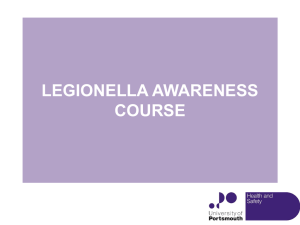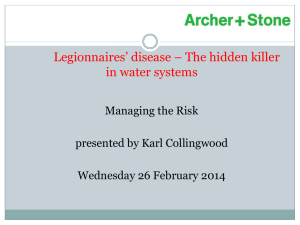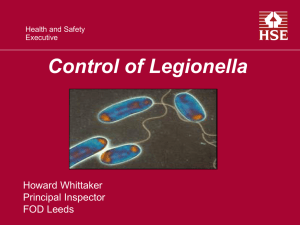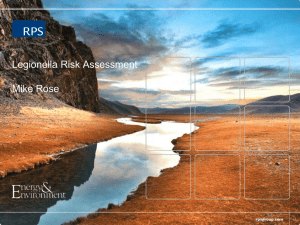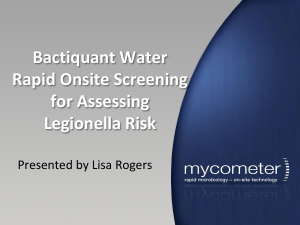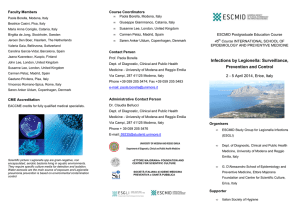Indholdsfortegnelse
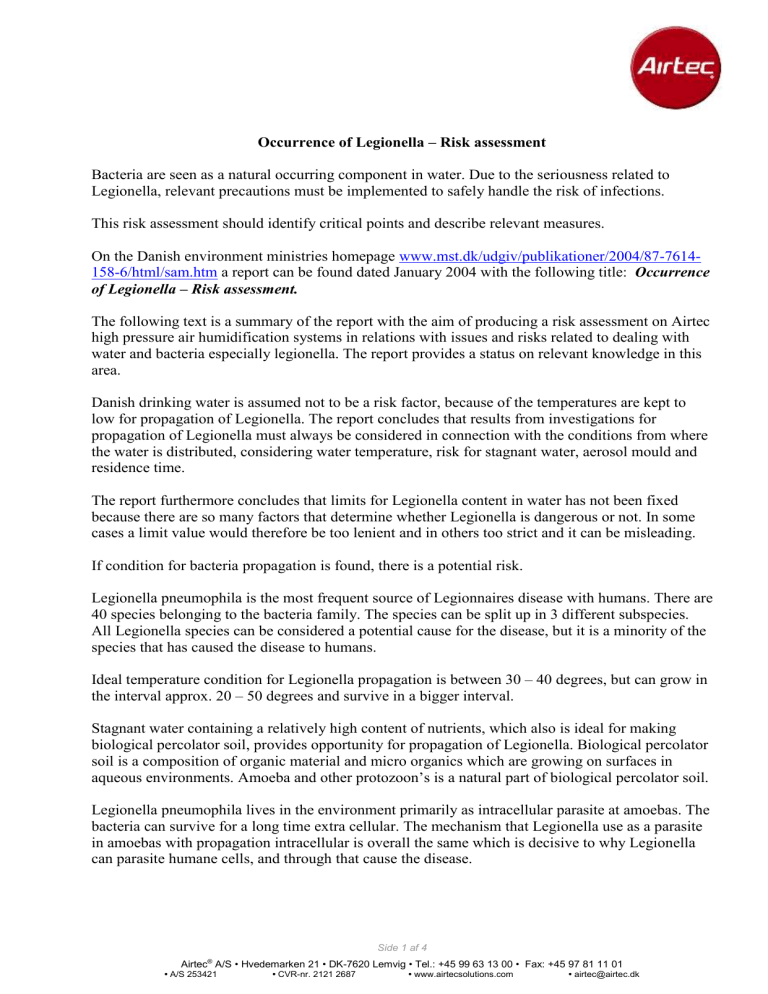
Occurrence of Legionella – Risk assessment
Bacteria are seen as a natural occurring component in water. Due to the seriousness related to
Legionella, relevant precautions must be implemented to safely handle the risk of infections.
This risk assessment should identify critical points and describe relevant measures.
On the Danish environment ministries homepage www.mst.dk/udgiv/publikationer/2004/87-7614-
158-6/html/sam.htm
a report can be found dated January 2004 with the following title: Occurrence of Legionella – Risk assessment.
The following text is a summary of the report with the aim of producing a risk assessment on Airtec high pressure air humidification systems in relations with issues and risks related to dealing with water and bacteria especially legionella. The report provides a status on relevant knowledge in this area.
Danish drinking water is assumed not to be a risk factor, because of the temperatures are kept to low for propagation of Legionella. The report concludes that results from investigations for propagation of Legionella must always be considered in connection with the conditions from where the water is distributed, considering water temperature, risk for stagnant water, aerosol mould and residence time.
The report furthermore concludes that limits for Legionella content in water has not been fixed because there are so many factors that determine whether Legionella is dangerous or not. In some cases a limit value would therefore be too lenient and in others too strict and it can be misleading.
If condition for bacteria propagation is found, there is a potential risk.
Legionella pneumophila is the most frequent source of Legionnaires disease with humans. There are
40 species belonging to the bacteria family. The species can be split up in 3 different subspecies.
All Legionella species can be considered a potential cause for the disease, but it is a minority of the species that has caused the disease to humans.
Ideal temperature condition for Legionella propagation is between 30 – 40 degrees, but can grow in the interval approx. 20 – 50 degrees and survive in a bigger interval.
Stagnant water containing a relatively high content of nutrients, which also is ideal for making biological percolator soil, provides opportunity for propagation of Legionella. Biological percolator soil is a composition of organic material and micro organics which are growing on surfaces in aqueous environments. Amoeba and other protozoon’s is a natural part of biological percolator soil.
Legionella pneumophila lives in the environment primarily as intracellular parasite at amoebas. The bacteria can survive for a long time extra cellular. The mechanism that Legionella use as a parasite in amoebas with propagation intracellular is overall the same which is decisive to why Legionella can parasite humane cells, and through that cause the disease.
Side 1 af 4
Airtec
® A/S • Hvedemarken 21 • DK-7620 Lemvig • Tel.: +45 99 63 13 00 • Fax: +45 97 81 11 01
• A/S 253421 • CVR-nr. 2121 2687 • www.airtecsolutions.com • airtec@airtec.dk
The conclusions of the analyses is linked to the knowledge relating to organism’s propagation conditions and the technical conditions on the water systems, providing a fresh perception which can be useful for the evaluation and preventive actions.
There are 2 perspectives related to actions minimizing risk:
1.
Actions that prevent propagation
2.
Actions that will reduce the number of Legionella bacteria.
The essential factor in preventing propagation of Legionella in water is
1.
Avoid temperatures 20 – 50 degrees
2.
Prevent stagnant water
3.
Minimize residence time
4.
Prevent high concentrations of nutrient.
The environments that fulfil the optimal propagation conditions for Legionella, is lukewarm stagnant water with a high organic content.
Several outbreaks of Legionnaires disease can be traced back to the fact that the installations haven’t been correctly maintained or the installations have not been used for a while.
UV-treatment of the water is among other a method to limit the propagation of bacteria. This method together with others, hasn’t achieved an approval from the relevant authorities and for most of the methods there are only a limited documentation for the efficiency in praxis.
Legionella will mostly infect through inhaling aerosols.
A proved dose -response connection for Legionella has not been identified at human beings. While there has been found high concentrations of Legionella without causing infection and opposite there has been infections, where the water test afterwards only showed moderate content of Legionella.
An explanation can be that water tests often are taken a while after the patient has been infected.
The bacterial count can at this time be considerable different from the bacterial count on the time of infect.
For most of the sporadic Danish incidents the trace back to the source of infection has been warm potable water.
The temperature is a decisive factor for the risk of a propagation of the Legionella. Legionella is not especially quickly growing and the residence time at a given temperature is therefore of great importance.
Temperature degrees Celsius
<20
Risk assessment
Survival must be expected but without propagation
Side 2 af 4
Airtec
® A/S • Hvedemarken 21 • DK-7620 Lemvig • Tel.: +45 99 63 13 00 • Fax: +45 97 81 11 01
• A/S 253421 • CVR-nr. 2121 2687 • www.airtecsolutions.com • airtec@airtec.dk
20 – 50 Weak to strong growing. The Intensity relates to the time at these temperatures. The range between 30 – 40 degrees is optimal for propagation.
>50 Weak to strong inactivation.
It is important to be aware that conditions where Legionella can survive are only acceptable as far as there has been no opportunity for propagation anywhere in the distribution line prior.
The use of surface water in combination with higher temperature level has a decisive importance for the quality of the raw water. In Denmark the raw water source is mainly subsoil water. Amoebas and Legionella have much harder access to subsoil water.
The demand for temperature for Danish drinking water is max. 12 degrees, where Legionella would not be able to propagate, but still can survive. It’s estimated that Legionella doesn’t pose a problem for the drinking water in Denmark.
The authority of the Netherlands has set a limit for Legionella in the tap water at 50 cfu/l, at distribution points with critical aerosol formation. The limit is however estimated to be low seen from a risk perspective.
Conclusion
The problems with Legionella ought to be prevented in a suitable way and extra caution towards high risk groups like sick and older people should be taken.
Legionella must be considered a naturally incoming environment bacterium, which doesn’t become a problem before propagation conditions are present.
The essential factors to prevent propagation of Legionella in water:
Stagnant water
Residence time
Water temperature
High concentrations of nutrient
These statements are taken directly form the Danish environment authority’s homepage. For further information or for deeper info please look at the following link: www.mst.dk/udgiv/publikationer/2004/87-7614-158-6/html/sam.htm
Generally the problems with legionnaires disease has be seen as a consequence of warm water systems and not in cold water systems.
Hygienically controlled Air humidification.
Airtec
®
systems are developed and handled in accordance with ISO 9001, ISO 14001 and ISO
22000 - Quality, Environment and Hygiene.
The critical design points considering the conclusion in the report
Side 3 af 4
Airtec
® A/S • Hvedemarken 21 • DK-7620 Lemvig • Tel.: +45 99 63 13 00 • Fax: +45 97 81 11 01
• A/S 253421 • CVR-nr. 2121 2687 • www.airtecsolutions.com • airtec@airtec.dk
Avoid stagnant water
Keep residence time low
Keep concentrations of nutrients low
Keep water temperatures low
Preventive action in Airtec system
RO water treatment system o Removes 98 % of all solids from the water o Theoretically removes 100 % of bacteria
UV sterilisation o Not recommended
Adding heat to the water
Mercury lamp
Efficiency level with amoebas not documented.
Pump construction o Frequency inverter adapts the water flow
No by pass of water
No use of old or recycled water
Water coming in, also passing out - Keeping temperatures low
Material choice o Choosing material with low migration o Force report available. o Hoses are kept to a minimum size, 10 mm diameter, to prevent larger quantities of
Control water taking residence in the pipelines. o Hygienic rinse
Changing the water in the water pipes every 6 hours automatically, default setting.
Service and installations o The systems should be handled and maintained by authorized personnel through scheduled visits.
Customer o Should follow the routines in the supplied user guide and report any variations.
Water report o Customer should always supply a water report that confirms high quality drinking water standards at consistent low temperatures.
50 bars pressure o At 50 bars pressure a living organism will be strongly influenced by the sudden change in pressure from 50 bars to atmospheric pressure.
Evaporation o Water born bacteria will not survive in a non water environment. Therefor it is essential in the design and operations of the systems that all water atomized is evaporated to the atmosphere.
Side 4 af 4
Airtec
® A/S • Hvedemarken 21 • DK-7620 Lemvig • Tel.: +45 99 63 13 00 • Fax: +45 97 81 11 01
• A/S 253421 • CVR-nr. 2121 2687 • www.airtecsolutions.com • airtec@airtec.dk
